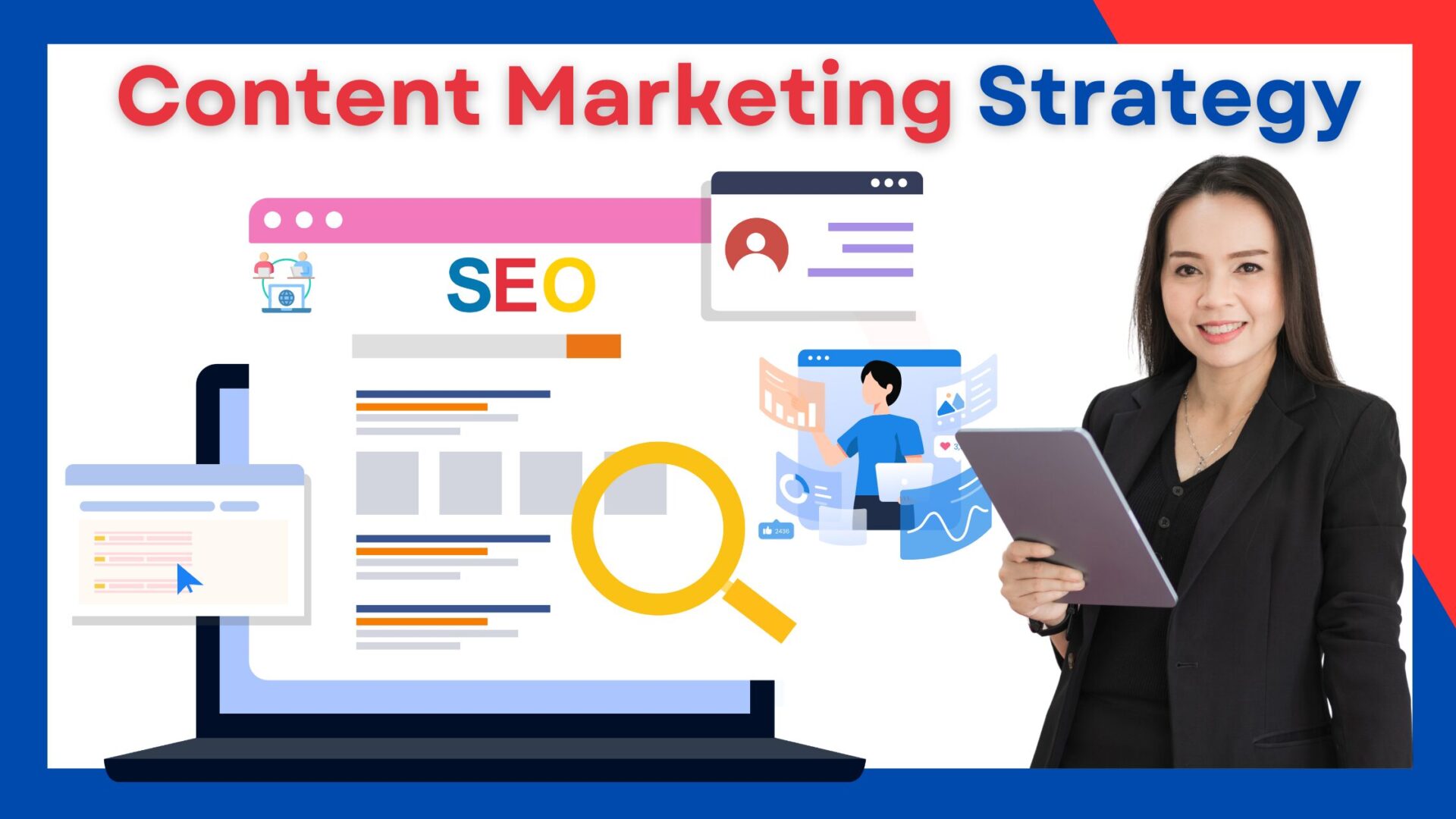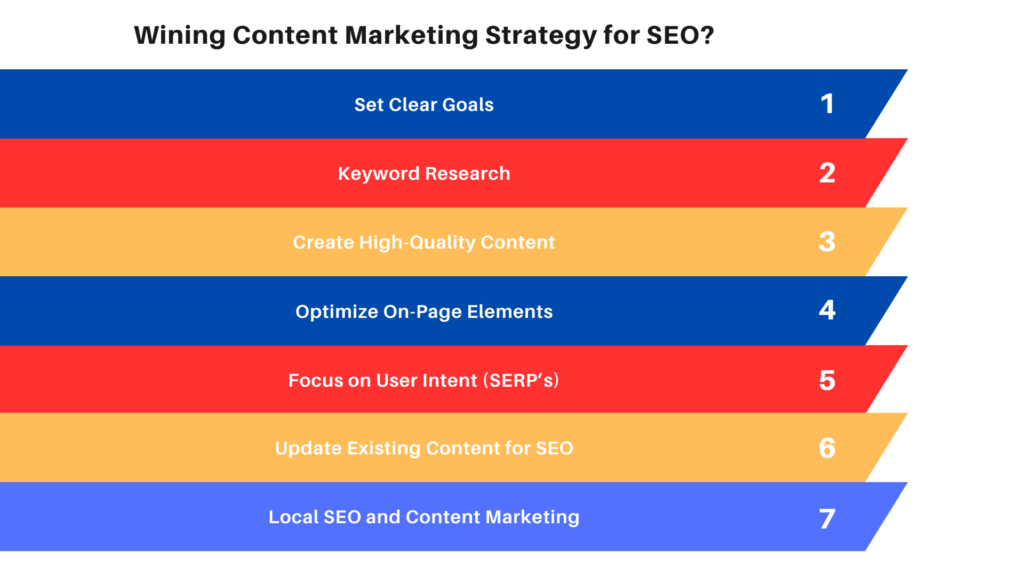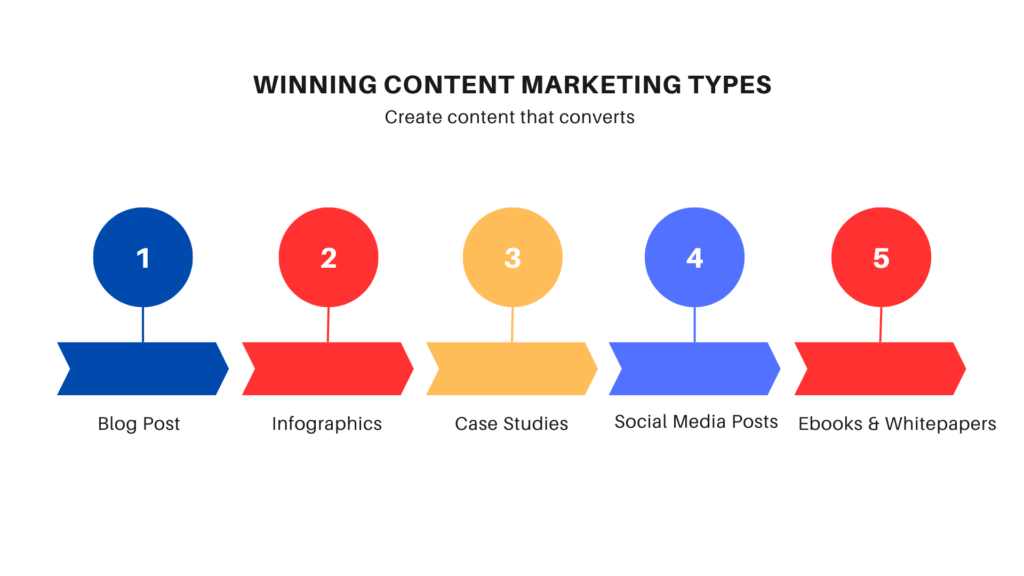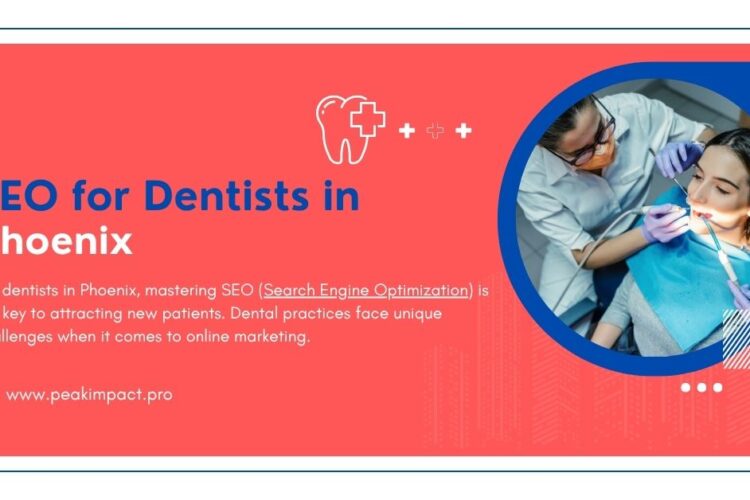
A well-structured content marketing strategy that will boost your website’s visibility, and traffic, improve user engagement and conversion/leads. With high-quality and unique content, you’ll grab potential clients and increase business revenue. According to SEO experts, with a content marketing strategy your business will grow up to 75%.
What is a Content Marketing Strategy?
An SEO content marketing strategy involves creating and optimizing high-quality content to rank higher in search engine results. SEO-friendly content combines with SEO techniques to improve visibility, attract traffic, engage audiences, and get more potential clients for businesses.
Quick View
Why is Content Marketing Important for SEO?
Content marketing plays an important role in SEO. High-quality content helps search engines as well as users of your websites and ranks higher in SERP’s. With a premium quality content marketing strategy your website 67% more leads and sales. Engaging, informative content keeps users on your site longer, which can make your website bounce rate lower and boost rankings.
How to Create Content Marketing Strategy for SEO?

1. Set Clear Goals
Define the purpose of your content and object. Your goals may include driving traffic, website conversion, generating leads, or building brand awareness for business.
2. Keyword Research
Use keyword research tools like SEMrush, Google Keyword Planner, or Ahrefs to find relevant keywords for your niche. Focus on high-volume, low-competition keywords to maximize visibility and traffic.
Example for local Search:
If you run a bakery, target keywords like “best bakery near me” or “gluten-free cakes in [your city].”
3. Create High-Quality Content
Write informative content that answers users queries. Use keywords naturally in headings, subheadings, and body text. Avoid keyword stuffing.
4. Optimize On-Page Elements
Make sure to optimize on-page SEO factors, such as:
- Title tags: Use relevant keywords.
- Meta descriptions: Write a concise summary of the page content.
- Headers: Use H1, H2, and H3 tags to structure your content.
5. Focus on User Intent
Create content based on user intent and SERP. Understand what users are searching for and answer their questions effectively.
Example:
For “content marketing strategies for local SEO,” create content targeting local customers, such as guides, blogs, and FAQs.
6. Use Visuals
Incorporate images, infographics, or videos in your content. Visuals increase engagement and improve the time users spend on your site.
7. Update Existing Content
Regularly update your content with fresh information. Adding new data, internal links, and images keeps your content relevant and improves SEO.
8. Local SEO and Content Marketing
For local SEO, create content targeting specific locations. Optimize for local keywords and include details like business address and working hours.
Example:
If you run a gym in London, create blog posts on “best exercises for weight loss in London gyms” or “fitness classes in London.”
Content Marketing Types

Content marketing is a powerful strategy that involves creating and sharing valuable content to engage your target audience and drive business growth.
Different types of content cater to various stages of the buyer’s journey and help achieve specific marketing goals. Here’s a breakdown of the most effective types of content marketing.
1. Blog Posts
Purpose: Educate, inform, and engage your audience.
Key Features: Blog posts are ideal for driving organic traffic through SEO. They establish your brand as a thought leader while addressing customer pain points.
Tips for Success:
- Focus on industry-specific topics and long-tail keywords.
- Include actionable advice and examples.
- Promote posts on social media and via email newsletters.
2. Infographics
Purpose: Simplify complex information with visually appealing graphics.
Key Features: Infographics are highly shareable and effective for breaking down data, statistics, or processes.
Tips for Success:
- Use tools like Canva or Adobe Illustrator for design.
- Keep visuals clean and data concise.
- Add branding and a clear call-to-action (CTA).
3. Videos
Purpose: Engage and educate your audience in an easy-to-consume format.
Key Features: Videos are versatile, ranging from product demos to testimonials and educational content.
Tips for Success:
- Use platforms like YouTube or Vimeo to host videos.
- Optimize video titles and descriptions for SEO.
- Include captions for accessibility.
4. Case Studies
Purpose: Showcase real-world success stories.
Key Features: Case studies build credibility by demonstrating how your product or service solves problems.
Tips for Success:
- Focus on measurable outcomes and detailed processes.
- Use quotes and testimonials from the client.
- Highlight challenges, solutions, and results.
5. Ebooks and Whitepapers
Purpose: Provide in-depth insights on complex topics.
Key Features: Ebooks and whitepapers are great for lead generation, as they often require email signup for access.
Tips for Success:
- Write content-rich documents with actionable insights.
- Design with professional templates for readability.
- Promote through email campaigns and landing pages.
6. Social Media Posts
Purpose: Drive engagement and promote brand awareness.
Key Features: Social media posts vary from short updates to engaging visuals or polls, reaching a broad audience.
Tips for Success:
- Tailor content for each platform (e.g., LinkedIn for professionals, Instagram for visuals).
- Post consistently and use analytics to track performance.
- Encourage interaction with questions or CTAs.
7. Webinars and Live Streams
Purpose: Educate and engage audiences in real-time.
Key Features: Webinars and live streams allow direct interaction, making them great for Q&A sessions or product launches.
Tips for Success:
- Choose relevant, high-interest topics.
- Invite industry experts to co-host.
- Record sessions for future use.
8. Email Newsletters
Purpose: Maintain regular communication with your audience.
Key Features: Newsletters are ideal for sharing updates, promotions, and curated content.
Tips for Success:
- Personalize emails with segmentation and dynamic content.
- Keep subject lines compelling to improve open rates.
- Use A/B testing to optimize performance.
9. Podcasts
Purpose: Build authority and connect with audiences through audio content.
Key Features: Podcasts are excellent for storytelling, interviews, and sharing expertise.
Tips for Success:
- Choose consistent themes and topics.
- Invest in quality audio equipment.
- Promote episodes across your marketing channels.
10. Interactive Content
Purpose: Boost engagement with dynamic formats.
Key Features: Quizzes, calculators, and polls encourage user participation and keep audiences engaged.
Tips for Success:
- Ensure the content is highly relevant to your audience.
- Use tools like Outgrow or Typeform for interactive design.
- Share results to encourage sharing and feedback.
11. User-Generated Content (UGC)
Purpose: Leverage content created by your audience.
Key Features: UGC builds trust and authenticity, as it’s shared by real users.
Tips for Success:
- Encourage reviews, testimonials, or social media posts from customers.
- Showcase UGC on your website and marketing materials.
- Offer incentives like discounts for participation.
12. Guides and How-To Content
Purpose: Provide practical solutions and step-by-step instructions.
Key Features: Guides and tutorials are highly actionable and cater to users searching for specific answers.
Tips for Success:
- Include visuals like screenshots or videos for clarity.
- Structure content with clear headings and numbered steps.
- Optimize for SEO with relevant keywords.
SEO Marketing Tactics to Improve Content Marketing Strategy
1. Use Backlinks
Get backlinks from authoritative websites to boost your site’s credibility and SEO. Collaborate with industry blogs for guest posting and link exchange.
2. Share on Social Media
Promote your content on social media channels. This increases your reach and drives traffic back to your website, improving your site’s SEO.
3. Optimize for Mobile
Ensure your content is mobile-friendly. With most users browsing on smartphones, a responsive site boosts user experience and SEO rankings.
4. Improve Page Speed
Optimize your website’s speed using tools like GTmetrix or PageSpeed Insights. Faster page loading keeps users engaged and reduces bounce rates.
FAQs
What is a content marketing strategy for SEO?
Answer: It’s a plan to create and optimize content for better search engine visibility and user engagement.
How does content marketing strategy help SEO?
Answer: Quality content improves your site’s relevance, helps you rank higher, and keeps users engaged longer.
Do content marketing strategies include SEO?
Answer: Yes, SEO is a key component of content marketing, ensuring your content reaches the target audience.
What are content marketing strategies for local SEO?
Answer: Create localized content, use local keywords, and add information like your address and business hours to target local customers.
How can I boost SEO with content marketing?
Answer: Use keyword research, create quality content, build backlinks, and optimize on-page elements.
Why is content marketing vital for SEO?
Answer: Content marketing helps search engines understand your site, delivers value to users, and improves your ranking.




